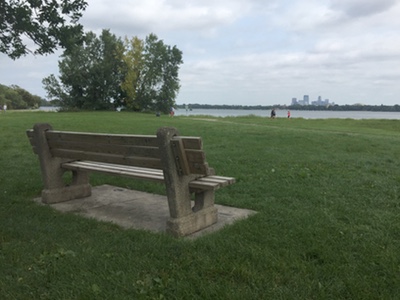
I recently walked past a park bench that I remember sitting on about 25 years ago. The wood is a little worn but the bench is still sturdy and the neighboring tree has grown into a lush protective canopy that exudes stable magnificent splendor.
I didn’t feel like sitting on the bench. Instead I chose to let my mind wander as I walked around the lake – a habit that is also one of my all-time favorite things to do.
As I walked around the big circle of water I began to contemplate how our habits shape our lives. I also pondered how common it is to view our accomplishments (or lack thereof) as a measure of our value in the world and the harbinger of who we are becoming.
How does this relate to yoga?
It is a fact that no matter what patterns and habits we choose, what asanas we practice and ‘accomplish,’ our bodies are going to change as our biological age increases. How our bodies will change is not as clear.
For the past few years, I’ve been really curious to see what a long-term study of the physical effects of different kinds of yoga asana would reveal. At present, evidence-based research is scarce. Perhaps 20 or 30 years from now there will be some sound longitudinal studies on the effects of inversions such as headstand and shoulderstand, as well as extreme hip openers, deep backbends and repetitive chaturangas and lunges.
Many of us, myself included, don’t need an evidence-based study to tell us the short-term positive effects of asana: pain reduction and injury prevention; mood enhancement; increased range of movement, strength, and energy, etc. A sense of accomplishment is another important factor to include in this list. However, I wonder how short-term accomplishments in asana serve us if we are concurrently developing or reinforcing habitual movements that could lead to long-term harm?
For example, if we habitually move into a backbend by creating an extreme movement in the lower lumbar spine, we may feel momentary exhilaration. But over time, that habit of movement may lead to injury and pain.
At the same time, this sense of immediate accomplishment can give us a boost of confidence that may guide us to take on challenges in other aspects of our lives that may serve us well long-term. Do the short-term positive effects of accomplishment override the possible negative long-term effects of developing physical habits that are harmful? Do we want to do a cost-benefit analysis of our yoga practice? These are questions I continue to explore.
Many of us practice yoga asana because it makes us feel better and we believe that it will serve us well in the present and over the long-term. As we practice, we explore habits and patterns. We toss some aside, reinforce others and create new ones. Ideally, we do this with an increasing sense of awareness and consciousness. I believe that both our current habits and how we view our accomplishments shape our experience of the moment and guide our future much more than the actual accomplishments.
In my work as a synagogue leader, I have the honor of sharing blessings, and I’d like to share one now:
As we continue on our paths, may we maintain and develop habits that serve us well. May we reflect with tenderness on past actions and habits that may have caused harm or are no longer needed. May we revel with appreciation and gratitude for those habits which have enhanced and continue to enhance or lives.
I don’t remember thinking about my habits and patterns when I sat on that bench 25 years ago. If I have the good fortune to be able to sit there 25 years from now, I wonder if it will be my habit to do so.


